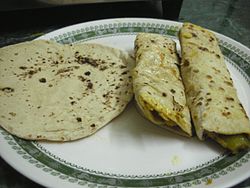- Chapati
-
Chapati 
Plain chapati and Stuffed rolled chapatisOrigin Alternative name(s) Roti Region or state South Asia, Central Asia & East Africa Dish details Main ingredient(s) Flour Chapati or Chapatti or Chapathi (Urdu: چپاتی, Hindi: चपाती, Bengali: চাপাটি, Kannada: ಚಪಾತಿ, Malayalam: ചപ്പാത്തി, Telugu: చపాతీ, Marathi: पोळी, Punjabi: ਚਪਾਤੀ [tʃəpɑt̪i]; Turkmen: Çapady) is an unleavened flatbread (also known as roti) from the Indian subcontinent.[1] Versions of it are found in Turkmenistan and in East African countries Kenya, Uganda and Tanzania. In China there is also a similar type of flatbread called Laobing.
Contents
History
The word 'chapati' is considered of Dravidian origin, from chappa meaning 'flattened' and attai or paathi means Husbands Food. Chapati is noted in Ain-i-Akbari , a 16th century document, by Mughal Emperor, Akbar’s vizier, Abu'l-Fazl ibn Mubarak.[1]
Definition
Chapatis are one of the most common forms in which wheat, the staple of northern South Asia, is consumed. Chapati is a form of roti or rotta (bread). The words are often used interchangeably. While roti,rotta refers to any flat unleavened bread, chapati is a roti made of whole wheat flour and cooked on a tava (flat skillet).
Cooking
Chapatis are made from a firm dough made from flour (whole grain common wheat), 'atta' in Urdu/Hindi/Punjabi/Bengali, and water. Some people also add salt and/or oil to the dough. Small portions of the dough are rolled out into discs much like a Mexican tortilla, using a rolling pin. The rolled-out dough is thrown on the preheated dry skillet and cooked on both sides. In some regions it is only partly cooked on the skillet, and then put directly on a high flame, which makes it blow up like a balloon. The hot air cooks the chapati rapidly from the inside. In some parts of northern India (e.g. Punjab) and Pakistan, this is called a phulka (that which has been inflated).
Often, the top of a chapati is slathered with butter or neyyi (clarified butter). A piece of chapati is torn off and used to pick up the meat or vegetable dish(es)that make the meal. It is folded into a sort of loose cone and used as a scoop to eat the more liquid dishes at a meal like pappu, paneer, or sena-galu.
Chapati sizes (diameter and thickness) vary from region to region and kitchen to kitchen. In Gujarat, for example, the chapati is called a 'rotli' and can be as thin as tissue paper. Chapatis made in domestic kitchens are usually not larger than 6-7 inches in diameter since the 'tava' from which they are made comes in sizes that fit comfortably on a domestic stove top. Tavas were traditionally made of unglazed earthenware, but are now typically made from metal. There are also electric tavas manufactured in India. The shape of the rolling pin also varies from region to region. Some households simply use a kitchen work top as a sort of pastry board, but homes have round flat-topped 'boards' specifically for rolling out chapatis that may be made of wood or stone.
Flat unleavened breads in South Asia come in many forms, the chapati is only one of them. A rotta, made of a dough similar to that used to make chapatis and cooked in an oven, is a 'tandoori roti'. The combination of wheat flour with one or more flours (e.g. chickpea, maize, or millet) will produce a "missi roti". Rottas made with pearl millet (bajra) or maize (makka) or jowar flour usually carry the name of the flour, as in "bajra roti" or "makke ki roti" (or "bhakri" in marathi). Flat breads like chapati and roti are traditionally a food of northern South Asia. The peninsular south, the east and northeast and the Kashmir valley are primarily rice-eating cultures. In southern India, there is a distinction made between a 'chapati' and its layered fried version the 'paratha'. 'Parathas' usually have a filling inside, such as spinach, cooked radish, or potato. Also now the 'tandoori roti' is to be found in the smallest towns.
See also
References
- ^ a b Of Bread Ain-i-Akbari , by Abu'l-Fazl ibn Mubarak. English tr. by H. Blochmann and Colonel H. S. Jarrett, 1873–1907. The Asiatic Society of Bengal, Calcutta, Volume I, Chap. 26, page 61.
 Indian breads
Indian breadsBaati • Bhakri • Bhatoora • Chapati • Davanagere Benne Dosa • Dosa • Idli • Jolada rotti • Kerala porotta • Khakhra • Kulcha • Luchi • Makki di roti • Manda Pitha • Naan • Neer dosa • Papadum • Paratha • Parotta • Pathiri • Pesarattu • Pitha • Puri (food) • Puttu • Rava dosa • Roti • Rumali Roti • Sheermal • Thalipeeth • Uttapam
Flatbreads Asia Barbari bread • Bazlama • Bhakri • Bhatoora • Bindaetteok • Bing • Bolani • Chapati • Dosa • Kulcha • Roast paan • Gözleme • Green onion pancake • Khanom buang • Laobing • Luchi • Malooga • Markook • Matzo • Naan • Papadum • Paratha • Pesarattu • Pita • Puri • Roti • Roti canai • Sanchuisanda • Sangak • Tandyr nan • Taboon bread • Yufka
Europe Crêpe • Crisp bread • Farl • Flammkuchen • Flatbrød • Flatkaka • Focaccia • Hoggan • Lavash • Lefse • Opłatek • Pancake • Pane carasau • Piadina • Pita • Podpłomyk • Rieska • Sacramental bread • Tunnbröd
Africa Aish Mehahra • Harsha • Injera • Lahoh • Mandezi • Ngome
Americas Arepa • Bammy • Casabe • Tortilla • Tortilla de Rescoldo
Bread Types Ingredients Equipment Processes Autolysis • Chorleywood bread process • Leavening • Maillard reaction • Proofing • Kneading • Baking • SteamingUses Other Breadmaking • Baker percentageCategories:- Andhra cuisine
- Bihari cuisine
- Bengali cuisine
- Burmese cuisine
- Flatbreads
- Indian breads
- Karnataka cuisine
- Malaysian cuisine
- Pakistani breads
- Pakistani cuisine
- Punjabi cuisine
- Muhajir cuisine
- Ugandan cuisine
- Singaporean cuisine
- Uttar Pradeshi cuisine
- Types of roti
Wikimedia Foundation. 2010.




